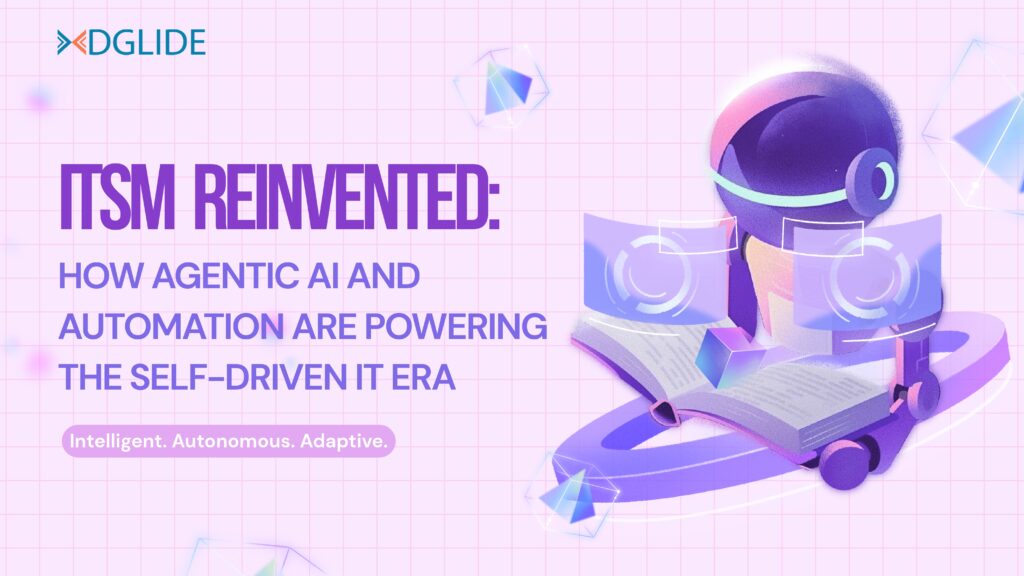The Evolution of ITSM
The landscape of IT Service Management (ITSM) is undergoing a massive transformation.
For years, IT teams have been burdened with repetitive tasks, manual workflows, and reactive problem-solving. But as we move into 2025, that old playbook is quickly being rewritten.
Today, AI and automation are not just tools—they’re the new foundation of IT operations.
If the 2010s were about digitization and the 2020s about digital transformation, then 2025 is the dawn of intelligent transformation.
At the heart of this new era lies an IT environment that doesn’t just respond to incidents—it predicts them, prevents them, and continuously learns to improve itself.
ITSM is evolving from a support function to a strategic business enabler—one that blends intelligence, experience, and adaptability.
AI Isn’t the Future—It’s the Now
Artificial Intelligence has already reshaped industries across the globe and ITSM is no exception.
Gone are the days when AI was limited to chatbots or ticket categorization.
Today, AI means foresight, systems that analyze, anticipate, and act before problems escalate.
Imagine this:
A service management system that recognizes recurring issues, predicts failures before they occur, and recommends solutions automatically. That’s the promise of AI-powered ITSM.
And now, we’re entering the age of Agentic AI, a smarter, more autonomous form of intelligence.
Unlike traditional Generative AI, which focuses on creating responses or content, Agentic AI acts. It takes informed decisions, executes tasks independently, and learns from every outcome.
By combining Generative AI’s creativity with Agentic AI’s autonomy, organizations can build IT systems that think, decide, and evolve, turning reactive operations into intelligent ecosystems.
This isn’t the future, it’s happening right now.
Automation: The Hidden Engine of Efficiency
Let’s face it, repetitive IT tasks are productivity drainers. Password resets, user provisioning, asset tracking, and change approvals consume countless hours every week.
Enter automation—the silent force driving IT performance and reliability.
By automating routine workflows, organizations can eliminate bottlenecks, reduce human errors, and ensure round-the-clock operational efficiency.
With the rise of hyperautomation—an intelligent blend of AI, machine learning, and robotic process automation (RPA)—the ITSM ecosystem is becoming self-operating.
Every process, from service request to incident resolution, is becoming connected, intelligent, and proactive.
The impact?
Response times cut in half
Ticket backlogs reduced dramatically
IT teams free to focus on innovation, strategy, and experience design
Automation doesn’t replace people—it amplifies their value.
It transforms IT from a reactive support arm into a catalyst for business growth.
The Self-Service Revolution
Modern employees expect instant solutions. They don’t want to wait in a ticket queue, they want quick answers, intuitive guidance, and seamless support.
That’s where AI-powered self-service comes in.
With Agentic AI, self-service platforms have evolved beyond traditional knowledge bases. They’re now intelligent assistants that:
Understand natural language queries
Learn from every user interaction
Create new help articles automatically
Even perform actions autonomously when authorized
Generative AI complements this by continuously enriching content, drafting new guides, troubleshooting steps, and FAQs based on real-world user behavior.
The outcome is a next-generation support experience, one that feels human, conversational, and immediate.
Users feel empowered, IT teams feel unburdened, and the organization experiences greater productivity.
From SLAs to XLAs: Experience is the New Currency
For decades, IT success was measured by SLAs—numbers like resolution time or uptime percentages.
But in 2025, success has a new name: Experience Level Agreements (XLAs).
The question is no longer “Did we fix it quickly?” but “Was the experience seamless and satisfying?”
With Agentic AI-driven analytics, IT leaders gain deep insights into:
Which processes frustrate users most
Where service demand peaks occur
How digital experiences impact business outcomes
By understanding not just the “what,” but the “why,” organizations can design IT experiences that delight, not just deliver.
This marks a powerful shift—from efficiency metrics to experience metrics, from service delivery to experience orchestration.
DGlide: Powering the Future of Intelligent ITSM
At DGlide, we’re at the forefront of this transformation.
We believe IT should be intelligent, predictive, and effortless—and we’re helping organizations make that vision real.
Our platform integrates Agentic AI, Generative AI, and automation across every layer of IT operations to deliver:
- Intelligent workflow automation that eliminates repetitive tasks
- Self-service experiences that feel conversational and human
- Predictive insights that detect issues before they disrupt users
- Real-time analytics that measure both performance and experience
With DGlide, ITSM becomes more than a system, it becomes a self-learning ecosystem that grows smarter with every interaction.
We don’t just automate, we elevate IT service delivery.
The Road Ahead: From Reactive to Autonomous ITSM
The future of ITSM is autonomous service management—where systems don’t just assist humans but collaborate with them.
In the near future, your IT environment will detect anomalies, resolve issues, document learnings, and evolve—all on its own.
Organizations that embrace Agentic AI and automation today will lead tomorrow—building stronger, adaptive, and people-centric IT ecosystems.
At DGlide, we’re helping businesses take that leap—from reactive operations to self-driven, intelligent IT ecosystems that never stop improving.
Final Thought
2025 isn’t just about managing IT, it’s about reimagining it.
As AI, automation, and experience intelligence converge, ITSM will no longer be a backend process, it’ll be the backbone of digital success.
The question isn’t if you’ll embrace intelligent ITSM—it’s when.
And with DGlide, the journey toward autonomous, adaptive, and agentic ITSM starts today.

